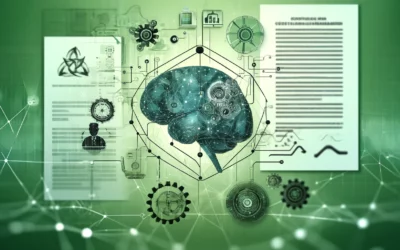A Necessary Step in Any Law Firm’s Digital Transformation
A Necessary Step in Any Law Firm’s Digital Transformation
As law firms begin to face clients’ growing skepticism with high hourly rates and service fees, proactive leaders are seeking long-term technological and organizational solutions. The prospect of an economic downturn places greater pressure on businesses to increase efficiency, streamline processes, and decrease costs.
One of the areas where law firms can gain the most in terms of efficiency is document automation. Moreover, this should be the first stage of the digital transition as it affects the overall feel and appearance of the lawyer’s final product.
What is document automation?
In simple terms, document automation is the process of converting frequently used documents or forms into dynamic templates which are then used to quickly draft new documents. Users are led through interactive elements (or Variants) which have been placed in a template or intelligent questionnaire. A document’s content will adjust according to a User’s data input and responses to questions. Documents, or sets of documents may also contain interdependencies (based on a system of conditions) which create a common logic within and among the documents. Much of a law firm’s practice focuses on integral, non-substantive tasks that devour a significant number of work hours (e.g., document preparation, revisions, standardization, editing and proofreading, etc.). Automation however, can make some of these tasks less time-consuming, or remove them all together, allowing lawyers more time for more value-adding activities.
Here are a few concrete examples of how document automation helps.
Increased efficiency and standard of provided services
- Standard clauses: Every law firm has standard clauses that appear across many different documents, such as Force Majeure or Choice of Law clauses. When it becomes necessary to modify one of these clauses, the change must be made in every single instance (and document) in which it appears.
Document automation tools keep standard clauses in one place. This means that when it comes time to update clauses (e.g. changed, or new regulations), you only need to make a change once for it to appear in all future documents.
- Consistency: Together with the standard clauses, certain design conditions, including numbering, Styles, and layout must be consistent across all documents. Consistency is difficult to maintain when different authors prepare and edit many different but related documents.
Automatically drafted documents remain consistent in all the above-mentioned aspects because the dynamic automated templates ensure that the established structure is maintained, and only approved vocabulary is used.
Consistency is closely linked to a firm’s image and reputation. Indeed, every document seen by a client should contain the same wording, structure (numbering, styles, etc.), and firm branding, etc. If, over the course of a year, your client receives the same type of document, drawn up in different ways, that client may start to question the differences, and speculate if one or more versions were inferior to others.
Consistency carries along with it the implied (high) standard of your firm.
- Institutional Knowledge: Some documents may require special actions going beyond the standard drafting of documents, such as additional permissions for transactions over a certain amount or obtaining extra information.
Additionally, it may prove necessary to disallow certain entries, contingent on the situation.
When manually preparing documents, the person creating the document is expected to recognize special circumstances and take appropriate action or select the correct options. As a document requires increased human input, the opportunity for human error also increases (i.e., duplicative data entry, transposed numbers, incorrect fields. etc.).
Two Roles
One of the key aspects of creating automated documents is the division between the following two roles:
- The Template Creator, i.e. a person who designs and builds an automated dynamic template, based on knowledge of the subject matter, or in collaboration with an experienced senior lawyer; and
- The User, i.e. the person who uses the automated template to draft the document. It is quite possible, and often the case that this person does not have a comprehensive knowledge of the content in the document. An example may be a sales rep who generates a sales contract based on an automated model sales contract created by a lawyer, or an administrative assistant uses an automated template to generate a standard notice letter.
Documents drafted from automated templates drastically reduce the chance of human error, especially when features such as help text and warning messages can be introduced seamlessly into the drafting (data entry/question answer) process. This allows the User to take all necessary actions to draft a good document prior to finalization and may block the entry of unauthorized information (e.g. too low a penalty for a particular kind of breach). A well-designed automated template empowers Users with the tools to draft accurate and vetted documents that can be adapted to every encountered situation.
The Template Creator, therefore, passes knowledge to the User through an intuitive automated design.
This knowledge transfer is not limited to Template Creators and the Users, but also between experienced lawyers (who may have supervised the creation of the template) and junior ones (who will now be able to easily access and draft accurate documents in their daily work), or even between the lawyers and administrative or marketing staff.
Let’s not forget the clients whose customer experience can be improved significantly through document automation. Just imagine a situation where a customer, rather than completing a Q&A form in an Excel workbook, instead fills in an interactive form sent to his e-mail. The same dynamic form then creates a document (or a set of documents) in the lawyer’s workspace.
Fast, effective, and innovative.
Review: Document Review is the critical final stage in the preparation of any document, and one that often takes a considerable amount of time. This is particularly true when documents have been prepared manually, as there is a higher probability of human error.
Document automation greatly improves a document’s accuracy during the drafting stage, i.e. in terms of date and number formats, page referencing, and multiple location data entry (when data is entered in one place, it is then automatically added to other places in which it appears – e.g. names, legal entities, defined terms).
The need to spend unnecessary hours reviewing minor mistakes is eliminated.
Generate valuable data!
Although the benefits are endless, one more that should not be forgotten is that documents drafted from automated templates generate (or at least should generate) tons of useful machine-readable metadata that can be leveraged for efficient document management, and analytics. Compare this to documents simply finalized and converted to PDF, whose data is much more difficult capture and use, and the value is clear.
Document Automation can be the first step in your journey to a modernized, digital future, where you can work efficiently and intelligently. It also opens the door to next generation LegalTech opportunities including deeper data analysis, which can be leveraged to explore potential artificial intelligence and machine learning opportunities.
As law firms begin to face clients’ growing skepticism with high hourly rates and service fees, proactive leaders are seeking long-term technological and organizational solutions. The prospect of an economic downturn places greater pressure on businesses to increase efficiency, streamline processes, and decrease costs.
One of the areas where law firms can gain the most in terms of efficiency is document automation. Moreover, this should be the first stage of the digital transition as it affects the overall feel and appearance of the lawyer’s final product.
What is document automation?
In simple terms, document automation is the process of converting frequently used documents or forms into dynamic templates which are then used to quickly draft new documents. Users are led through interactive elements (or Variants) which have been placed in a template or intelligent questionnaire. A document’s content will adjust according to a User’s data input and responses to questions. Documents, or sets of documents may also contain interdependencies (based on a system of conditions) which create a common logic within and among the documents. Much of a law firm’s practice focuses on integral, non-substantive tasks that devour a significant number of work hours (e.g., document preparation, revisions, standardization, editing and proofreading, etc.). Automation however, can make some of these tasks less time-consuming, or remove them all together, allowing lawyers more time for more value-adding activities.
Here are a few concrete examples of how document automation helps.
Increased efficiency and standard of provided services
- Standard clauses: Every law firm has standard clauses that appear across many different documents, such as Force Majeure or Choice of Law clauses. When it becomes necessary to modify one of these clauses, the change must be made in every single instance (and document) in which it appears.
Document automation tools keep standard clauses in one place. This means that when it comes time to update clauses (e.g. changed, or new regulations), you only need to make a change once for it to appear in all future documents.
- Consistency: Together with the standard clauses, certain design conditions, including numbering, Styles, and layout must be consistent across all documents. Consistency is difficult to maintain when different authors prepare and edit many different but related documents.
Automatically drafted documents remain consistent in all the above-mentioned aspects because the dynamic automated templates ensure that the established structure is maintained, and only approved vocabulary is used.
Consistency is closely linked to a firm’s image and reputation. Indeed, every document seen by a client should contain the same wording, structure (numbering, styles, etc.), and firm branding, etc. If, over the course of a year, your client receives the same type of document, drawn up in different ways, that client may start to question the differences, and speculate if one or more versions were inferior to others.
Consistency carries along with it the implied (high) standard of your firm.
- Institutional Knowledge: Some documents may require special actions going beyond the standard drafting of documents, such as additional permissions for transactions over a certain amount or obtaining extra information.
Additionally, it may prove necessary to disallow certain entries, contingent on the situation.
When manually preparing documents, the person creating the document is expected to recognize special circumstances and take appropriate action or select the correct options. As a document requires increased human input, the opportunity for human error also increases (i.e., duplicative data entry, transposed numbers, incorrect fields. etc.).
Two Roles
One of the key aspects of creating automated documents is the division between the following two roles:
- The Template Creator, i.e. a person who designs and builds an automated dynamic template, based on knowledge of the subject matter, or in collaboration with an experienced senior lawyer; and
- The User, i.e. the person who uses the automated template to draft the document. It is quite possible, and often the case that this person does not have a comprehensive knowledge of the content in the document. An example may be a sales rep who generates a sales contract based on an automated model sales contract created by a lawyer, or an administrative assistant uses an automated template to generate a standard notice letter.
Documents drafted from automated templates drastically reduce the chance of human error, especially when features such as help text and warning messages can be introduced seamlessly into the drafting (data entry/question answer) process. This allows the User to take all necessary actions to draft a good document prior to finalization and may block the entry of unauthorized information (e.g. too low a penalty for a particular kind of breach). A well-designed automated template empowers Users with the tools to draft accurate and vetted documents that can be adapted to every encountered situation.
The Template Creator, therefore, passes knowledge to the User through an intuitive automated design.
This knowledge transfer is not limited to Template Creators and the Users, but also between experienced lawyers (who may have supervised the creation of the template) and junior ones (who will now be able to easily access and draft accurate documents in their daily work), or even between the lawyers and administrative or marketing staff.
Let’s not forget the clients whose customer experience can be improved significantly through document automation. Just imagine a situation where a customer, rather than completing a Q&A form in an Excel workbook, instead fills in an interactive form sent to his e-mail. The same dynamic form then creates a document (or a set of documents) in the lawyer’s workspace.
Fast, effective, and innovative.
Review: Document Review is the critical final stage in the preparation of any document, and one that often takes a considerable amount of time. This is particularly true when documents have been prepared manually, as there is a higher probability of human error.
Document automation greatly improves a document’s accuracy during the drafting stage, i.e. in terms of date and number formats, page referencing, and multiple location data entry (when data is entered in one place, it is then automatically added to other places in which it appears – e.g. names, legal entities, defined terms).
The need to spend unnecessary hours reviewing minor mistakes is eliminated.
Generate valuable data!
Although the benefits are endless, one more that should not be forgotten is that documents drafted from automated templates generate (or at least should generate) tons of useful machine-readable metadata that can be leveraged for efficient document management, and analytics. Compare this to documents simply finalized and converted to PDF, whose data is much more difficult capture and use, and the value is clear.
Document Automation can be the first step in your journey to a modernized, digital future, where you can work efficiently and intelligently. It also opens the door to next generation LegalTech opportunities including deeper data analysis, which can be leveraged to explore potential artificial intelligence and machine learning opportunities.
More Industry Insights


















